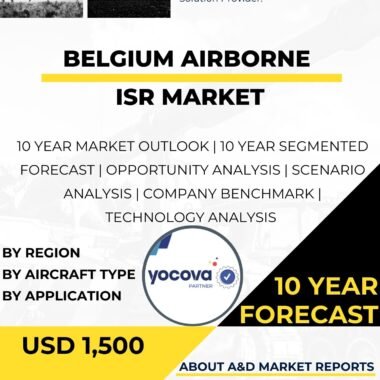Description
Australia Airborne ISR Market
The Australia Airborne ISR Market is a rapidly expanding sector that strengthens the nation’s defense capabilities and national security. Airborne ISR (Intelligence, Surveillance, and Reconnaissance) relies on advanced aircraft and sensor systems to collect real-time intelligence from the air. As a country with vast territory and evolving security challenges, Australia continues to invest in cutting-edge ISR technologies to boost situational awareness and improve decision-making.
Market Overview of the Australia Airborne ISR Market
The Australia Airborne ISR Market has grown significantly in recent years. This rise is linked to the country’s focus on enhancing intelligence-gathering and strengthening surveillance across land, sea, and air domains. As threats become more sophisticated, the demand for advanced ISR platforms continues to increase. Modern ISR systems help monitor adversaries, assess risks, and support rapid response during crises.
Key Drivers of the Australia Airborne ISR Market
Enhancing Maritime Domain Awareness
One major driver for the Australia Airborne ISR Market is the need for strong maritime surveillance. With vast coastlines and a large Exclusive Economic Zone (EEZ), Australia faces challenges such as illegal fishing, smuggling, and border intrusion. Airborne ISR platforms—especially maritime patrol aircraft and UAVs—play a crucial role in detecting suspicious activities and supporting search and rescue missions.
Strengthening Intelligence and Reconnaissance Capabilities
Advanced ISR aircraft equipped with high-resolution sensors, cameras, and radar systems allow Australia to capture real-time data across large geographic areas. These capabilities are essential for defense planning, military operations, and national security decisions.
Encouraging Indigenous Defense Innovation
The Australia Airborne ISR Market also benefits from strong collaboration between the government, industry, and research institutions. This cooperation supports the development of indigenous ISR solutions tailored to Australia’s defense needs. It also boosts the defense industrial base, creates skilled jobs, and expands opportunities for technology export.
Applications of the Australia Airborne ISR Market
Military Operations
In military settings, airborne ISR platforms support intelligence gathering, battlefield surveillance, and reconnaissance missions. They help monitor potential threats, track enemy movements, and provide crucial support to ground forces.
Maritime Surveillance and Border Security
Maritime patrol aircraft with advanced radar systems offer extended surveillance over oceans and coastal regions. They allow Australia to maintain strong control over its maritime territories and protect national interests.
Counter-Terrorism and Law Enforcement
Airborne ISR systems support domestic security efforts by monitoring critical infrastructure, enhancing emergency response, and strengthening counter-terrorism operations.
Defense Exports
Australia’s growing expertise in ISR platforms also contributes to defense exports. Offering high-quality ISR solutions positions Australia as a strategic partner for allied nations.
Challenges in the Australia Airborne ISR Market
Technical Complexity
Airborne ISR platforms rely on highly sophisticated sensors, communications networks, and data-processing systems. Developing and operating these technologies requires significant expertise and investment.
Resource Allocation and Funding
Sustaining ISR capabilities demands continuous funding for research, development, procurement, and training. Balancing these costs with other defense priorities remains a major challenge.
Interoperability Issues
Integrating different ISR assets into a unified network is essential for maximizing efficiency. Seamless communication and data sharing between platforms are critical for achieving full operational effectiveness.
Future Outlook for the Australia Airborne ISR Market
The Australia Airborne ISR Market is expected to continue its strong growth trend. As Australia works to expand situational awareness and strengthen national security, demand for modern ISR platforms will remain high. Ongoing investment in research and development, industry collaboration, and a focus on system interoperability will drive further advancements in ISR technology.
Conclusion
The Australia Airborne ISR Market plays a vital role in strengthening the nation’s defense posture. Advanced ISR platforms help Australia gather real-time intelligence, monitor threats, and respond quickly to emerging risks. Strong government commitment, technological innovation, and growing defense partnerships will continue to drive market growth. Overcoming challenges related to complexity, budgeting, and system integration will be essential to fully unlocking the potential of airborne ISR capabilities in Australia.




